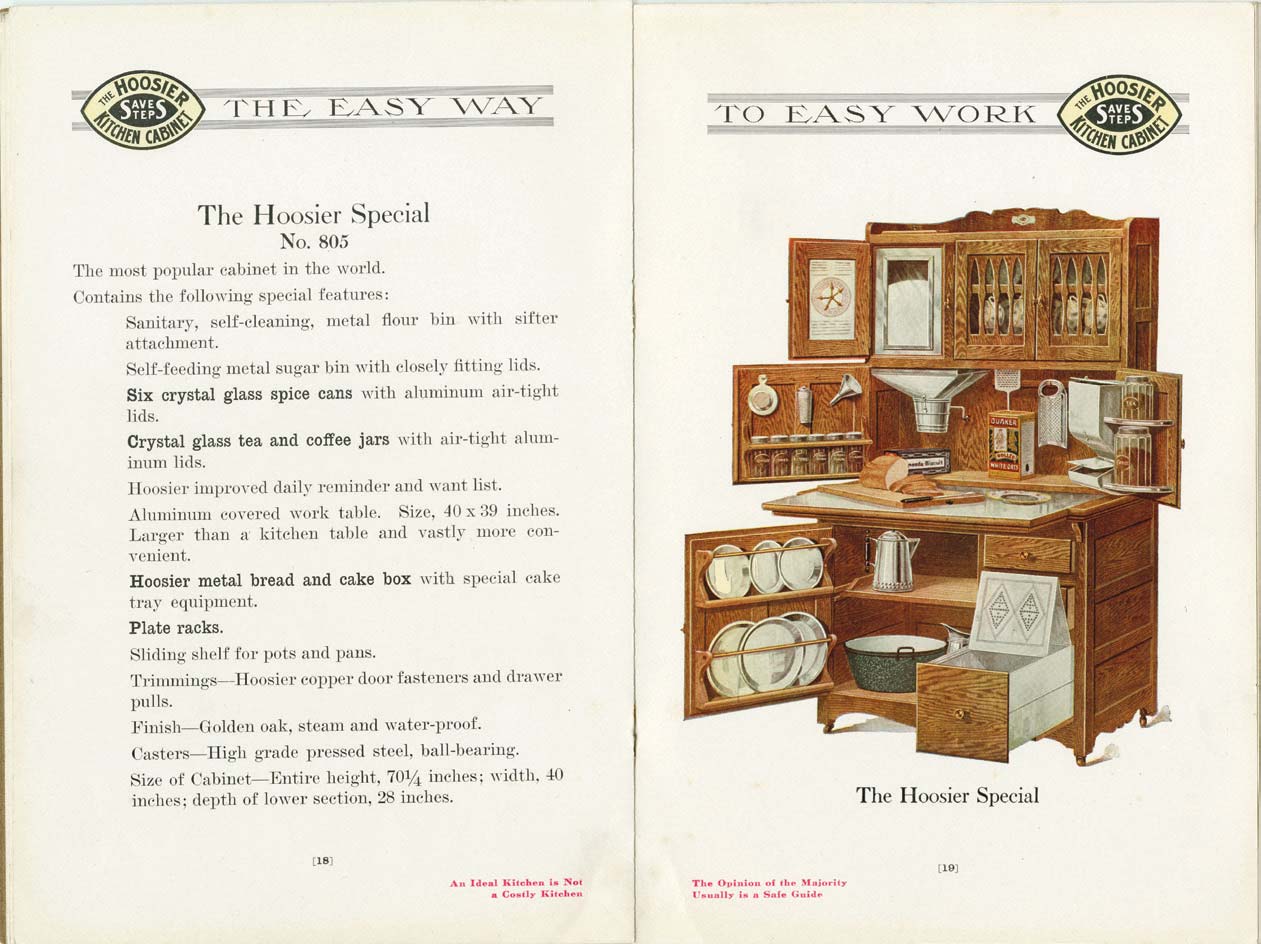Steps Saved Stepping Back in Time
 Historical photography and quotes courtesy of the Indiana Historical Society and The Hoosier Cabinet in Kitchen History by Nancy R. Hiller.
Historical photography and quotes courtesy of the Indiana Historical Society and The Hoosier Cabinet in Kitchen History by Nancy R. Hiller.
Mrs. F.T. Noeson, Bear Lake, Pennsylvania: “I have no piece of furniture in my well equipped home that helps as much to make the housework easy as my Hoosier Cabinet. My baking days are enjoyed instead of dreaded. Everything is at hand ready for use and it is a pleasure and satisfaction to use them.” —From The Hoosier Cabinet in Kitchen History by Nancy R. Hiller
Early in 2019, I paged through a recent issue of Food and Wine—turning the pages quickly, occasionally noting something delicious and speed reading through the intricate recipe, retaining nothing.
Until one word caught my eye.
“Hoosier.”
The article, “Why Kitchen Islands Rule,” shared decor tips, upgrades and even a nod to the Kardashians as a part of the wild popularity of a kitchen island today. It also included a sidebar highlighting the history of the kitchen island. The claim was that today’s kitchen islands evolved from the Hoosier cabinet, popular in the early 1900s.
“Do they mean Indiana Hoosier,” I wondered.
I pulled out my phone and, sure enough, it was Indiana’s own moniker gracing the pages of Food and Wine and—evidently—shaping today’s kitchen.
The cabinet was thought to be the first kitchen workstation, full of storage for equipment, ingredients and plenty of prep space, allowing the home cook to stay in one place. The “Hoosier” nickname arose because the New Castle–based Hoosier Manufacturing Company was one of the first and largest producers of the cabinets. These cabinets were so popular that it was believed that in 1920, one in 10 homes had one.
More curiosity set in and continued to simmer as summer arrived. While reading The Library Book by The New Yorker reporter Susan Orlean, I was reminded that a library houses more than books. It also houses a community’s heart, soul and history.
The library.
Of course.
I freed up an afternoon and took the trip downtown to explore the Indiana Historical Society’s William H. Smith Library.
What I figured would be interesting turned out to be magical.
In the library’s collection, I touched 100-year-old pages from sales trainings and brochures from the Hoosier Manufacturing Company. Delicate documents that highlighted the different models of cabinets and all they could do. I reviewed the many advertisements that were printed in the cabinet’s heyday in the Sears Roebuck & Co catalog, Ladies’ Home Journal and Good Housekeeping. These ads featured strategy and messaging that was cutting edge for the time and shaped much of marketing today. I even let out an amused laugh when I read about the “Hoosier Council of Kitchen Scientists,” a group of women with titles such as “Household Consultant” designed to aid the everyday cook with the use of her Hoosier cabinet. Basically, the influencers of the turn of the century.
 In Bloomington woodworker and writer Nancy R. Hiller’s book The Hoosier Cabinet in Kitchen History, published by Indiana University Press in 2009, I stepped in to the kitchen of the homemaker of the turn of the century. Simple spaces, yet complicated as cellars kept food cool, kitchen gardens kept food fresh, pantries kept equipment clean and all of this kept the cook on her feet.
In Bloomington woodworker and writer Nancy R. Hiller’s book The Hoosier Cabinet in Kitchen History, published by Indiana University Press in 2009, I stepped in to the kitchen of the homemaker of the turn of the century. Simple spaces, yet complicated as cellars kept food cool, kitchen gardens kept food fresh, pantries kept equipment clean and all of this kept the cook on her feet.
But also in Hiller’s beautiful use of scholarly narrative, I stepped into the homemaker’s shoes.
Her wants and needs were not all that different from the modern homemaker’s: The demands in and outside the house were many. There were kids, husbands and communities that needed her. The kitchen was a woman’s province, but it was highly physical, highly invisible and she needed a hack to make her life in the kitchen easier.
So well over a decade before the Instant Pot and meal delivery kits, the Hoosier cabinet saved time and steps to aid in getting meals on the table more efficiently. Leaving the museum’s library, I fought the urge to hug each of the librarians who had assisted me that day. Their devotion to history—Indiana’s in particular—helped bring it to life.
However, there was someone else that needed a “Thanks.” And so the final part of my Hoosier cabinet odyssey led me to a phone call to Hiller, the author of the book that took me to another place and introduced me to the housewife of that time.
She delighted me with a fun, quick conversation as I shared how her book taught me so much more than just what a Hoosier cabinet is. She taught me all the nuance, culture and history packed into its drawers: Part women’s liberation, part man’s innovation. Part style, part function. Part further driving the “oppressive” nature of kitchen work, part bringing the kitchen to the center of the home.
Hiller, a cabinet maker in Bloomington, stressed she is more an expert on period kitchens and doesn’t work on Hoosier cabinets in her cabinetry work today, but told me she, obviously, enjoys them.
“They are like a giant toy,” she says, “a wonderful expression of what was going on [at the time] culturally and scientifically.”
A time when the nation was fixated on efficiency and women were just beginning to be called out of what were once traditional roles.
Thinking of the housewife of the 1900s while preparing dinner that evening, I glanced down to the herbs and vegetables on my cutting board from our wanna-be kitchen garden, a garden that is a hobby of mine in my attempt to live a little slower in this still efficiency-obsessed culture.
But, then I looked up.
My husband was across from me, putting together burgers for the grill. Our two small children, together on a step stool, were splashing at the kitchen sink. (Or, as they like to believe, “helping.”)
All of us, together, around the kitchen island. Our kitchen workstation and the center of our home.
All thanks to her, and the Hoosier cabinet.

A 1900s KITCHEN
The kitchen began to be a more important room in the home, but without cabinetry the homemaker logged many steps. The first Hoosier cabinets were called “Step Savers” in hopes of bringing popular obsession with efficiency on the farm and in the workplace into the home so all the kitchen “things” were together.
The cabinet was well organized and featured a place for everything. Spices, baking needs, equipment, even shopping lists, conversion charts and meal planners were found on the inside of the cabinet’s doors.
The Hoosier cabinet’s success was thanks to the changing times in homemaking, but, also innovative sales and advertising. The Hoosier Manufacturing Company saw the opportunity to capitalize on the interest of the general public and established a network of dealers that sold directly to customers with the support of captivating print ads. Their annual advertising budget was $200,000.

HOOSIER ROOTS
It is believed that by 1920 the Hoosier Manufacturing Company, based out of New Castle, made and sold 2 million Hoosier cabinets, producing upwards of 700 per day. Other firms in Indiana such as G.I. Sellers in Elwood and Coppes Brothers and Zook in Napanee did well in the years Hoosier cabinets were a standard.
A FALL FROM FASHION
Yet the Hoosier cabinet’s popularity began to decline around 1930 due to the Depression and, eventually, the rise in built-in kitchen cabinets.
Though today’s homemaker doesn’t need a Hoosier cabinet to do all that it once could, Hiller shared they can still be a great work surface and element of décor, but cautioned to be prepared for their size. Copious wall and floor space will be needed for this large, historical piece of furniture.




